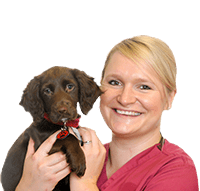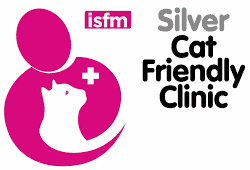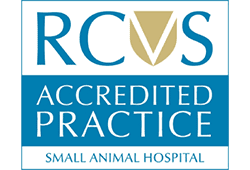What Does Brachycephalic Mean?
The term Brachycephalic means short head, dogs with this conformation have a flatter face than other breeds. Typical brachycephalic breeds include English bulldogs, French bulldogs, Pekingese, Boxers, Boston terriers, pugs, Cavalier King Charles Spaniels, Brussels griffon, Boston Terriers, and Shih Tzus. Not all dogs of these breeds are affected by Brachycephalic Obstructive Airway Syndrome (BOAS).
What is Brachycephalic Obstructive Airway Syndrome (BOAS)?
The term Brachycephalic Obstructive Airway Syndrome (BOAS) generally refers to compromised air movement through the upper airways (nose, mouth, voice box) and trachea (windpipe) resulting from brachycephalic head conformation. Brachycephalic dogs typically have shortened skulls and a flat face appearance.
In dogs affected by BOAS excessive amounts of soft tissue in the nose and throat block air from getting into their lungs when they breathe. The short skull shape of brachycephalic dogs means there is less space for the soft tissues of the nose and throat, and they are compressed together into a smaller space, blocking the airway. In some cases, the trachea (windpipe) is also much narrower when compared to other similar-sized dogs, further reducing the ability of air to get into the lungs.
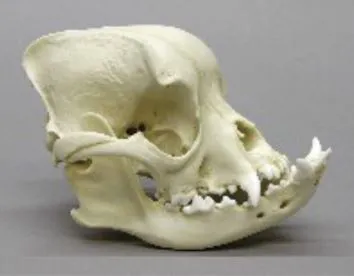 Fig 1.1: Pug Skull
Fig 1.1: Pug Skull 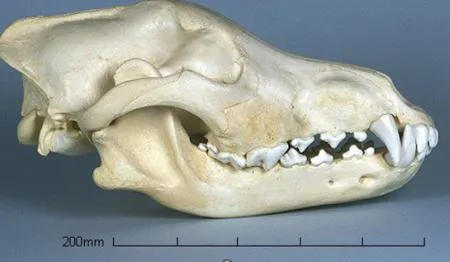 Fig 1.2: German Shepard Skull
Fig 1.2: German Shepard Skull
Why do Brachycephalic Breeds have Difficulty Breathing?
Brachycephalic dogs have severely compromised upper airways, which increases the resistance to airflow making it more difficult for them to exercise and regulate their temperature. The increased resistance to airflow is due to primary anatomical abnormalities and secondary acquired changes.
Main primary abnormalities include:
Stenotic Nares
Excessively narrow nostrils restrict air from flowing smoothly, requiring increased effort to breathe, resulting in heavy, noisy breathing. Some dogs cannot breathe through their nose at all and become obligate mouth breathers, often stopping breathing when they fall asleep (sleep apnoea).
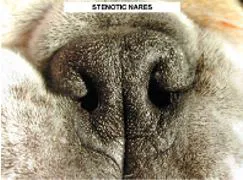 Fig 2.1 Stenotic nares of a brachycephalic dog
Fig 2.1 Stenotic nares of a brachycephalic dog 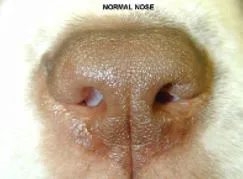 Fig 2.2: Normal nares
Fig 2.2: Normal nares
Elongated (and in some cases thickened) Soft Palate
The soft palate is the flap of tissue that hangs down from the back of the roof of the mouth (hard palate). In brachycephalic dogs, the soft palate is longer and sometimes thicker than normal. It can block the larynx, obstructing the flow of air into the windpipe.
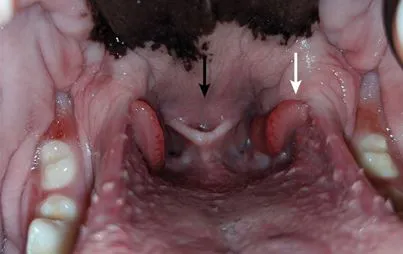 Fig 3.1: Black arrow= over long soft palate, white arow= hyperplastic tonsils
Fig 3.1: Black arrow= over long soft palate, white arow= hyperplastic tonsils 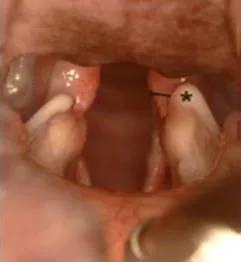 Fig 3.2: Normal soft palate and larynx
Fig 3.2: Normal soft palate and larynx
Hypertrophied Nasal Turbinate
The folds of tissue inside the nose may be thickened, and too close together, stopping air from passing through the nose easily. In some cases these folds of tissue also extend from the nose into the throat (aberrant nasal turbinate’s).
Hypoplastic Trachea
A narrower than normal windpipe. This is particularly a problem in English Bulldogs.
Hypertrophy of the Tongue
The tongue in dogs with BOAS is often larger and thicker than other dogs. These dogs store fat in their tongue and so being overweight can make this problem worse.
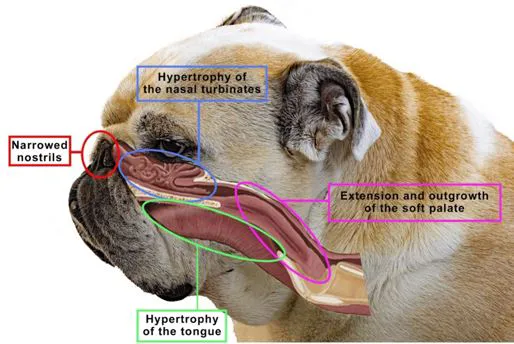
Secondary Problems
Dogs with BOAS will commonly develop other problems as a result of the difficulties of the negative pressure created by struggling to breathe through narrow airways.
Hyperplastic (enlarged inflamed tonsils)
The negative pressure of struggling to breathe through narrow airways can cause the tonsils to become thickened, enlarged and inflamed. These large tonsils contribute to obstruction of the airway.
Laryngeal Collapse
High-speed jets of air flowing down a narrowed larynx can cause inflammation, swelling and oedema of the mucosa tissue lining the voice box (the larynx). The mucosa can be sucked into the lumen of the larynx by the turbulent airflow; this is known as everted laryngeal saccules and represents the first stage of laryngeal collapse.
Over time, cartilage that supports the larynx may become weakened, eventually causing the larynx to collapse, severely narrowing the size of the airway (stages 2 and 3 of laryngeal collapse). Laryngeal collapse is often associated with a worsening of clinical signs and advanced cases can be difficult to treat.
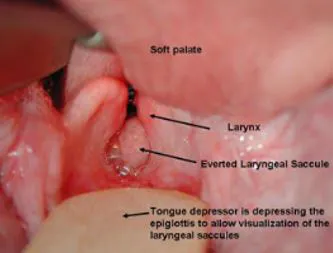 Fig 4.1: Everted laryngeal saccule
Fig 4.1: Everted laryngeal saccule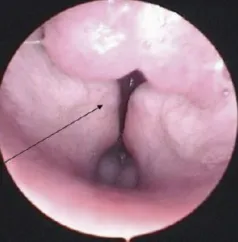 Fig 4.2: Grade 3 laryngeal collapse
Fig 4.2: Grade 3 laryngeal collapse
Tracheal Collapse
The trachea may lose its structural support, making breathing more difficult and causing a chronic cough to develop.
Middle Ear Disease
The auditory tube can become blocked resulting in a build-up of fluid in the middle ear (“glue ear”). This can be associated with ear infections and can reduce hearing.
Acid Reflux and Heartburn
Many brachycephalic dogs develop stomach acid reflux and chronic oesophagitis (heartburn). These dogs will often vomit or regurgitate their food or water or bring up a thick foam. Regurgitation can be associated with eating, or may occur when the dog gets excited or is exercising.
Pneumonia
Brachycephalic dogs have a significantly increased risk of developing pneumonia from inhaling saliva, water or food into their lungs.
What are the Signs of BOAS?
The signs of BOAS are varied and can range in severity, and may include some or all of the following:
- Snorting or snoring at rest or during exercise
- Noisy breathing
- Excessive panting and difficulty breathing during exercise
- Exercise intolerance
- Poor tolerance to heat stress
- Restlessness at night
- Sleep apnoea
- Frequent retching, regurgitation, vomiting
- Collapse due to lack of air.
Signs of brachycephalic airway syndrome may be mild or may eventually become so severe that life-threatening respiratory distress develops. Some dogs have so much difficulty breathing that they are unable to sleep for long periods of time. Dogs may stop breathing for short times while sleeping (sleep apnoea). Some dogs may adapt to sleep in strange positions with their head propped up or their neck extended or fall asleep with a toy in their mouth to keep their mouth open to help their breathing.
Dogs with BOAS struggle in hot weather more than other breeds as they are not easily able to regulate their temperature. These dogs can easily develop heat exhaustion, which can be fatal.
Dogs that are able to cope most of the time, may be tipped over from coping to being in difficulty by hot weather, exercise, stress or pain due to another illness or injury. Severely affected dogs may turn blue and pass out from lack of oxygen. Dogs can die from BOAS.
Although the airway problems involved with BOAS are usually apparent from a young age, dogs often become clinically affected as they become adults. Most dogs are two to four years old before they are brought to a Vet for evaluation and treatment. It is recommended that you seek veterinary advice if you have noticed any of the clinical signs outlined above.
What Treatments Are Available for BOAS?
Several surgical procedures are available to support patients suffering from BOAS. The three main components of BOAS can be corrected surgically, usually with good to excellent results.
- Stenotic nostrils can be widened so that air can flow easily into the nasal cavity (rhinoplasty)
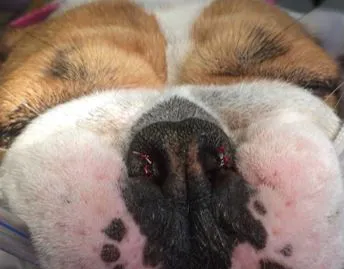
- The elongated soft palate can be trimmed to an appropriate length and made thinner so that it will no longer interfere with normal airflow into the trachea (staphylectomy or folded flap platoplasty)
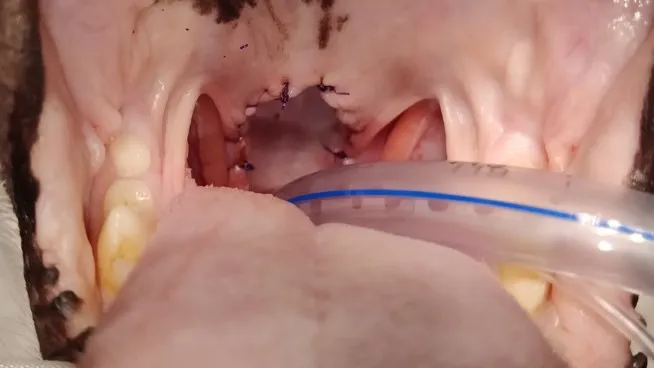
- Everted laryngeal saccules and enlarged tonsils can be removed.
What can I Expect if my Dog Undergoes BOAS Surgery?
Most dogs suffering from clinical signs of BOAS that receive prompt, appropriate treatment can experience a significant improvement in ease of breathing and exercise tolerance. As it is not possible to create a completely normal airway for the brachycephalic dog, pets can remain prone to heat stress, and many are unlikely to be able to exercise to the same extent as dogs with regular head confirmation. It is also likely that some respiratory noise will continue despite the surgery.
Surgery to the nares, soft palate, and larynx generally slows the progression of voice box collapse (laryngeal collapse) by improving airflow and reducing the negative pressures developed during respiration. Early diagnosis and treatment aim to maximise the benefits of surgery and minimise the risks of significant voice box collapse later in life.
Many dogs do not experience further significant deterioration in the voice box and so do not require additional surgery. Despite treatment, voice box collapse can, however, reach a critical level in some patients, and so further surgery may be required.
Some dogs with hyperplastic nasal turbinates may require a specialist procedure called LATE (laser-assisted turbinectomy) to remove these structures using laser surgery.
Many dogs with gastrointestinal problems due to BOAS such as difficulty putting on weight and regurgitation of food and foam will improve following surgery to help their airways. Some will fully recover. Some may need medication to help with their gastrointestinal problems. Some dogs with BOAS may have other underlying conditions contributing to their gastrointestinal problems such a hiatal hernia, or swallowing abnormalities and if a significant improvement in these symptoms is not seen after treatment for BOAS, then further investigation is recommended.
BOAS Grading Assessment
The Kennel Club and University of Cambridge's Respiratory Function Grading Scheme assesses Bulldogs, French Bulldogs and Pugs for brachycephalic obstructive airway syndrome.
The scheme advises owners if their dog is affected by BOAS and gives guidance to breeders on how to lower the risk of producing affected puppies.
Dogs can be assessed from the age of 12 months, and this should be repeated every two years for their lifetime or until they are no longer used for breeding.
At Kentdale, we provide detailed exercise tests for patients with compromised upper airways. Through personalised surgical plans, our Specialist team provide exceptional patient care whilst significantly improving airflow and exercise tolerance for flat-faced breeds.
For more details, visit The Kennel Club’s website: https://www.thekennelclub.org.uk/health-and-dog-care/health/getting-started-with-health-testing-and-screening/respiratory-function-grading-scheme/
BOAS Fixed Price Packages
At Kentdale Referrals, we are committed to supporting our patients, clients and referring vets in achieving the best possible diagnosis and treatment plan. That is why we now offer fixed package prices to support a smooth referral process and ensure transparency of costs for our clients.


